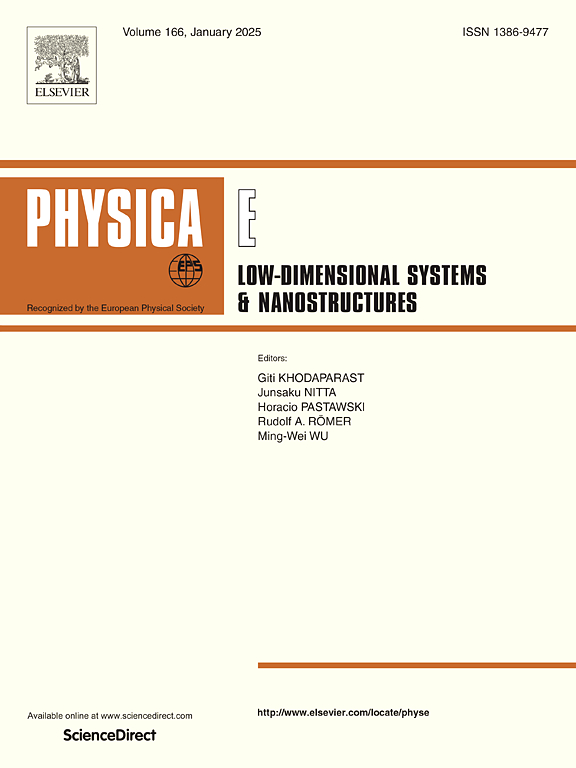RKKY interaction in triangular graphene nanobubble
IF 2.9
3区 物理与天体物理
Q3 NANOSCIENCE & NANOTECHNOLOGY
Physica E-low-dimensional Systems & Nanostructures
Pub Date : 2025-06-25
DOI:10.1016/j.physe.2025.116315
引用次数: 0
Abstract
Using the Lanczos method as a numerically exact theoretical framework, we investigate the Ruderman–Kittel–Kasuya–Yosida (RKKY) interaction in the triangular graphene nanobubble. Our results demonstrate that Saremi’s rule remains valid in the charge-neutral triangular graphene nanobubble. However, the characteristic decay of the RKKY interaction observed in pristine graphene is disrupted when both magnetic impurities are located within the nanobubble. This decay behavior is restored when one impurity is positioned far from the nanobubble center, regardless of the other impurity’s location. By tuning the height of the nanobubble, the strength of the RKKY interaction can be enhanced by up to three orders of magnitude compared to that in pristine graphene. Moreover, we reveal that carrier doping, which shifts the Fermi level away from the Dirac point, can induce a transition from anti-ferromagnetic to ferromagnetic RKKY coupling between impurities on opposite sublattices, depending on the nanobubble height. These findings provide new insights into the manipulation of magnetic interactions in nanostructured graphene systems and pave the way for potential applications in graphene-based spintronic devices.
三角形石墨烯纳米泡中的RKKY相互作用
使用Lanczos方法作为精确的数值理论框架,我们研究了三角形石墨烯纳米泡中的Ruderman-Kittel-Kasuya-Yosida (RKKY)相互作用。我们的研究结果表明,Saremi规则在电荷中性三角形石墨烯纳米泡中仍然有效。然而,当两种磁性杂质都位于纳米泡中时,原始石墨烯中观察到的RKKY相互作用的特征R - 3衰变被破坏。当一种杂质被放置在远离纳米泡中心的位置时,不管另一种杂质的位置如何,这种衰变行为都会恢复。通过调整纳米气泡的高度,与原始石墨烯相比,RKKY相互作用的强度可以提高三个数量级。此外,我们发现,载流子掺杂使费米能级远离狄拉克点,可以诱导相对亚晶格上杂质之间从反铁磁到铁磁的RKKY耦合转变,这取决于纳米气泡的高度。这些发现为纳米结构石墨烯系统中磁相互作用的操纵提供了新的见解,并为石墨烯基自旋电子器件的潜在应用铺平了道路。
本文章由计算机程序翻译,如有差异,请以英文原文为准。
求助全文
约1分钟内获得全文
求助全文
来源期刊
CiteScore
7.30
自引率
6.10%
发文量
356
审稿时长
65 days
期刊介绍:
Physica E: Low-dimensional systems and nanostructures contains papers and invited review articles on the fundamental and applied aspects of physics in low-dimensional electron systems, in semiconductor heterostructures, oxide interfaces, quantum wells and superlattices, quantum wires and dots, novel quantum states of matter such as topological insulators, and Weyl semimetals.
Both theoretical and experimental contributions are invited. Topics suitable for publication in this journal include spin related phenomena, optical and transport properties, many-body effects, integer and fractional quantum Hall effects, quantum spin Hall effect, single electron effects and devices, Majorana fermions, and other novel phenomena.
Keywords:
• topological insulators/superconductors, majorana fermions, Wyel semimetals;
• quantum and neuromorphic computing/quantum information physics and devices based on low dimensional systems;
• layered superconductivity, low dimensional systems with superconducting proximity effect;
• 2D materials such as transition metal dichalcogenides;
• oxide heterostructures including ZnO, SrTiO3 etc;
• carbon nanostructures (graphene, carbon nanotubes, diamond NV center, etc.)
• quantum wells and superlattices;
• quantum Hall effect, quantum spin Hall effect, quantum anomalous Hall effect;
• optical- and phonons-related phenomena;
• magnetic-semiconductor structures;
• charge/spin-, magnon-, skyrmion-, Cooper pair- and majorana fermion- transport and tunneling;
• ultra-fast nonlinear optical phenomena;
• novel devices and applications (such as high performance sensor, solar cell, etc);
• novel growth and fabrication techniques for nanostructures

 求助内容:
求助内容: 应助结果提醒方式:
应助结果提醒方式:


